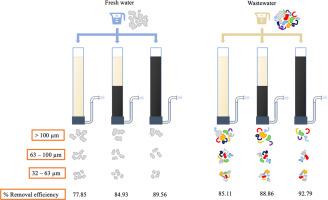Performance of intermittent sand and coke filters for the removal of size-ranged microplastics
IF 7.7
Q2 ENGINEERING, ENVIRONMENTAL
引用次数: 0
Abstract
Microplastics (MPs) are a growing environmental problem that threaten living organisms, especially in water ecosystems. One of the main sources of MPs in water environments are wastewater treatment plants, which remove the majority of these micropollutants, but large amounts keep reaching the environment daily. To achieve a larger removal on MPs in wastewater, intermittent filtration sets as an efficient and cheap alternative. In this work, three laboratory-scale filters were tested, with different filtration media (sand, sand/coke and coke) to compare their performance with PP-spiked freshwater and real wastewater samples in removing MPs from different size ranges, from larger than 32 µm to 100 µm. Sand/coke and coke filters showed the best results, with a general microplastic removal efficiency of up to 92.79 ± 2.78 % for wastewater and 89.56 ± 2.19 % for PP-spiked water. This removal efficiency decreased with smaller MPs, reaching up to 90.87 ± 3.46 % for wastewater and 76.28 ± 8.54 % for PP-spiked water. Significant differences were found on efficiencies for PP-spiked water and wastewater, especially in the range from 32 to 63 µm, where biofilm formed on pores surface with wastewater filtration may play an important role for the removal of these MPs.

间歇式砂焦过滤器去除大小不一的微塑料的性能
微塑料(MPs)是一个日益严重的环境问题,威胁着生物体,尤其是水生态系统中的生物体。废水处理厂是水环境中 MPs 的主要来源之一,虽然废水处理厂能去除大部分微污染物,但每天仍有大量微塑料进入环境。为了更大程度地去除废水中的 MPs,间歇过滤是一种高效、廉价的替代方法。在这项工作中,使用不同的过滤介质(沙、沙/焦炭和焦炭)对三种实验室规模的过滤器进行了测试,以比较它们与添加了聚丙烯的淡水和实际废水样本在去除不同尺寸范围(从大于 32 微米到 100 微米)的 MPs 方面的性能。沙/焦炭和焦炭过滤器的效果最好,对废水和添加 PP 的水的微塑料去除率分别为 92.79 ± 2.78% 和 89.56 ± 2.19%。随着微塑料含量的减少,去除率也随之降低,废水的去除率为 90.87 ± 3.46 %,添加 PP 的水的去除率为 76.28 ± 8.54 %。发现添加 PP 的水和废水的去除率存在显著差异,尤其是在 32 至 63 µm 的范围内,废水过滤时在孔表面形成的生物膜可能对这些 MPs 的去除起到了重要作用。
本文章由计算机程序翻译,如有差异,请以英文原文为准。
求助全文
约1分钟内获得全文
求助全文
来源期刊

Journal of hazardous materials advances
Environmental Engineering
CiteScore
4.80
自引率
0.00%
发文量
0
审稿时长
50 days
 求助内容:
求助内容: 应助结果提醒方式:
应助结果提醒方式:


